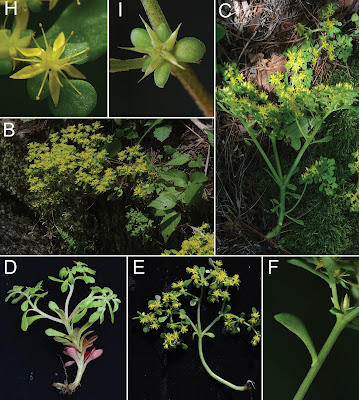 |
| Sedum simingshanense Y.L. Xu, in She, Zhang, Zhou, Peng, Yao, Zhao, Yang et Xu. 2025. |
Abstract
In this paper, Sedum simingshanense sp. nov. is described as a new species based on morphological and molecular analyses, and its taxonomic relationships are discussed. Morphological analysis indicates S. simingshanense should be classified in the genus Sedum sect. Sedum and is distinct from the related species S. xunvense and S. formosanum in the morphology of its solitary, light green and smooth stems, flattened leaves, larger, obovate and spurless sepals, yellow anthers, 22–30 ovules per carpel, oblique follicles, and its habitat on shaded slopes or rocks. Phylogenetic analysis of sequences of the nuclear ribosomal internal transcribed spacer (ITS) also demonstrates that S. simingshanense has a highest similarity of only 97.22% with any known species and S. formosanum is the closest extant relative of the new species.
Key words: ITS, morphological characters, new species, phylogenetic analysis, Sedum simingshanense
Sedum simingshanense Y.L. Xu, sp. nov.
Similar species: The new species is similar to S. xunvense and S. formosanum. It is mainly distinguished from them in the morphology of its solitary, light green and smooth stems, flattened leaves, larger, obovate and basally spurless sepals, yellow anthers, 22–30 ovules per carpel, oblique follicles, and its habitat on shaded slopes or rocks. In the vegetative state, it resembles Sedum alfredii, but S. alfredii has partly sterile and clustered stems, and purple-red or slightly red and smooth fertile stems (Fu and Ohba 2001). The distinguishing characteristics of the new species and the three morphological relatives are listed in detail in Table 1.
Etymology: The specific epithet ‘simingshanense’ refers to the type locality [Siming Mountain Geopark (Yuyao county, Zhejiang province)] of the new species.
Shi-Qi She, Yang Zhang, Xin Zhou, Ya-Jun Peng, Shen-Hao Yao, Xing-Xing Zhao, Jia Yang and Yue-Liang Xu. 2025. Sedum simingshanense (Crassulaceae), A New Species from Zhejiang, East China. PhytoKeys. 251: 23-35. DOI: doi.org/10.3897/phytokeys.251.125595
